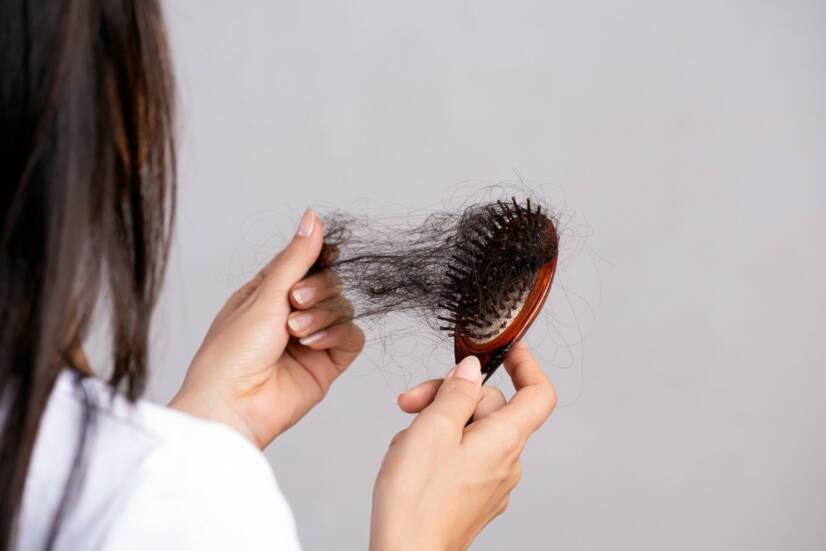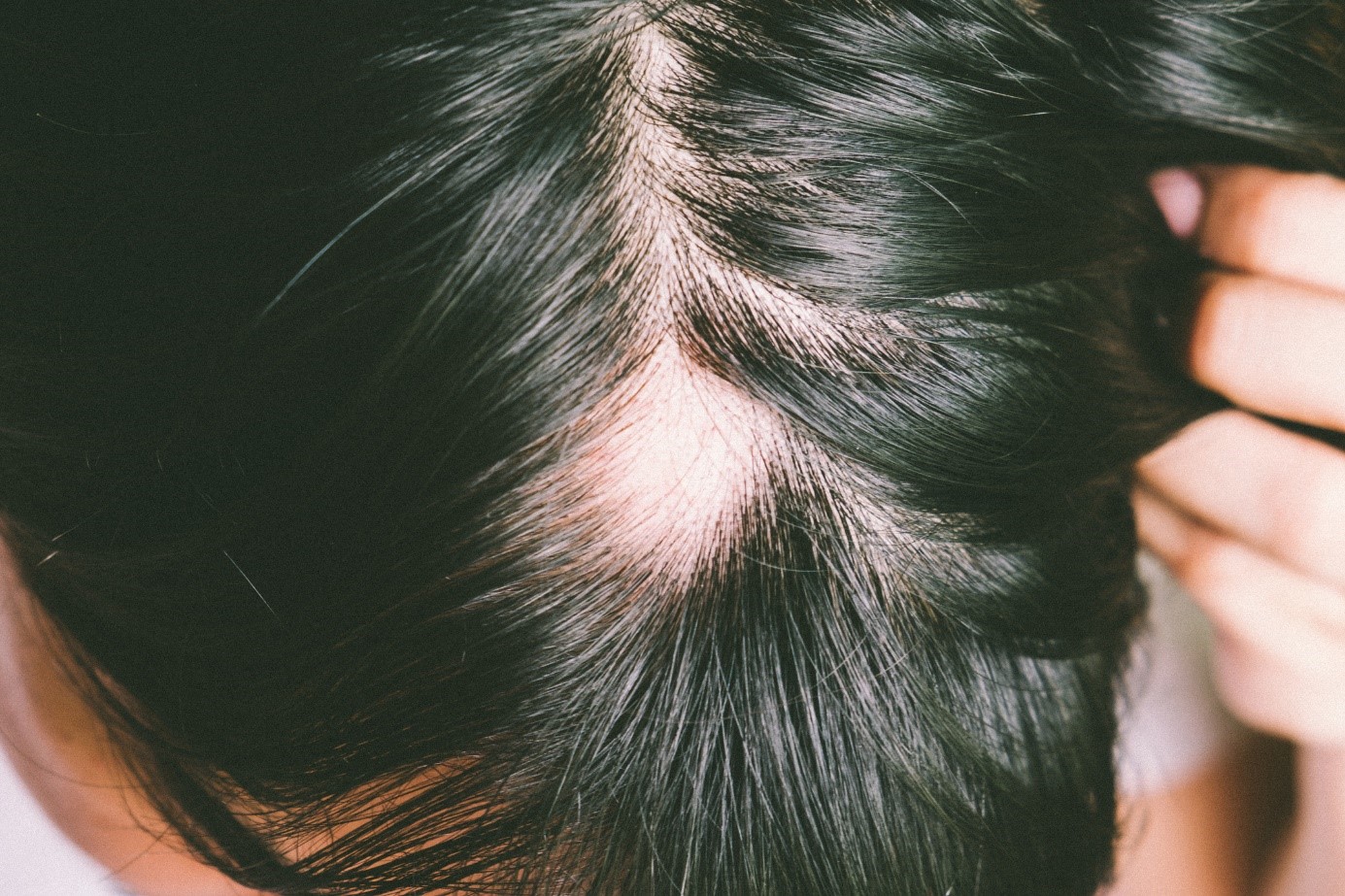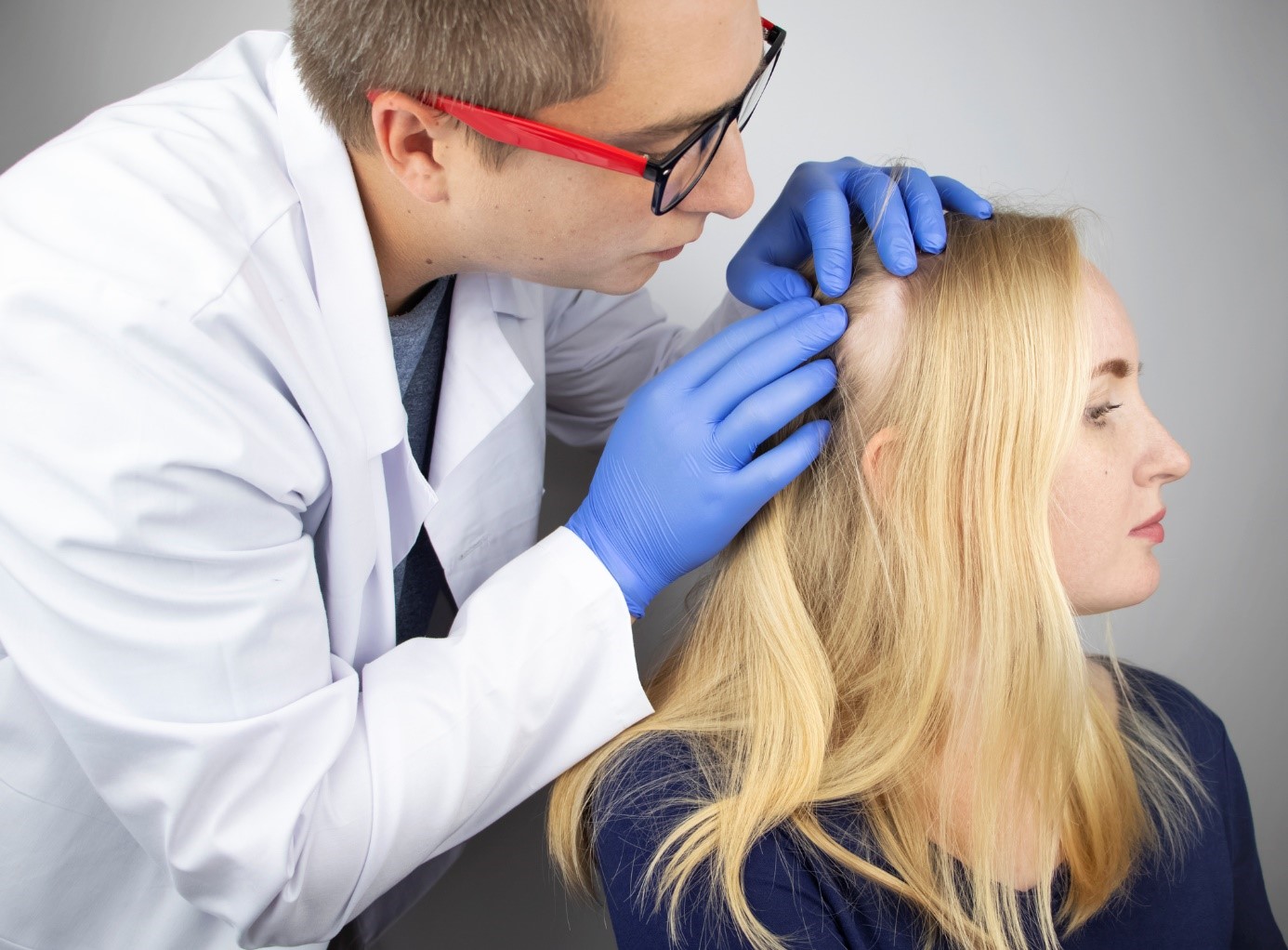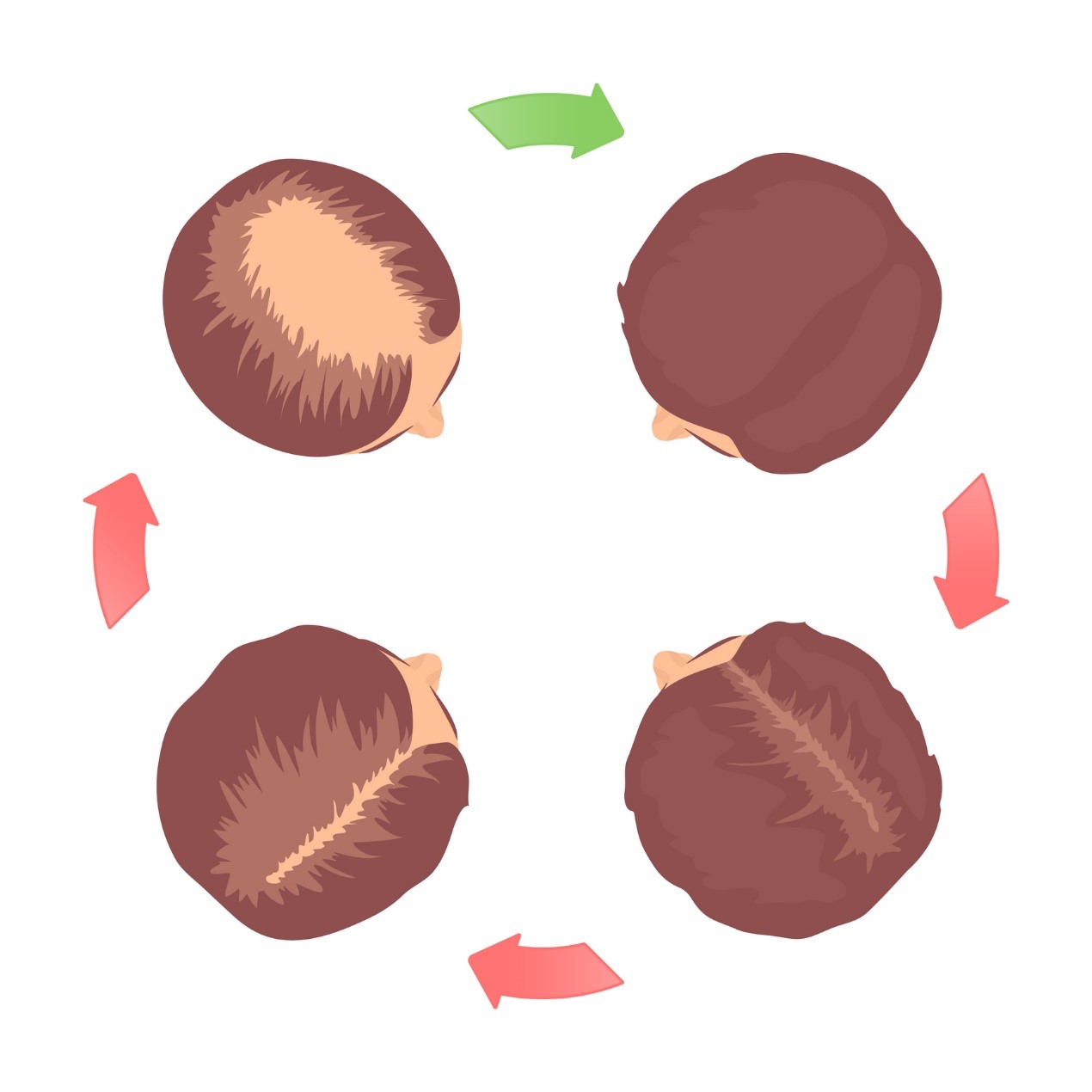- prolekare.cz - Diffuse hair thinning in women in clinical practice
- prolekare.cz - Mesotherapy in trichology
- prolekare.cz - Dermatoscopic diagnosis of alopecia
- prolekare.cz - Dihydrotestosterone and steroid 5α-reductase inhibitors
- prolekare.cz - Brief repetition about hair cycle and hair follicle
Alopecia (a condition of reduced hair quantity): what are its causes and symptoms?

Hair is considered to be the crown of beauty. It has a great influence on a person's overall appearance. Hair damage, which manifests itself in changes in colour, thickness and texture, is one of the reasons why we seek medical attention. What is alopecia?
Most common symptoms
- Loss of pubic hair
- Hyperpigmentation
- Scars
- Excessive Hair Loss: Causes, Treatment
- White patches on the skin
- Dry skin
- Itchy skin
- Reddened skin
Characteristics
Before describing the issue of hair loss itself, we need to understand some basic characteristics. Let's describe what a hair is made of and what the hair growth cycle is.
The structure of the hair
The hair is part of the pilosebaceous unit, whose name is derived from the Latin words pilus (hair) and sebum. Each hair grows from a hair follicle. The hair follicle can be thought of as a sac on the scalp that extends into a deeper layer of the skin, the dermis.
The basic functions of the hair follicle include:
- synthesis and anchoring of the hair shaft (the visible part of the hair)
- production and secretion of sebum
- an important reservoir of Langerhans cells and melanocytes
The hair follicle is composed of epithelial and connective tissue components.
The connective components include the nourishing blood vessels and nerves, the dermal papilla and the connective sheath. The papilla and its connective sheath form a functional unit. The papilla contains blood vessels that supply oxygen and nutrients to the growing hair.
The epithelial components include the matrix, the pith, the cortex and the cuticle. The most important epithelial part of the hair follicle is the hair matrix. The hair matrix is the germinal mass that surrounds the papilla.
The hair is composed of three layers:
1. the pith (medulla)
The pith can be thought of as a channel located in the central (inner) part of the hair shaft. It contains keratin, which is considered a key building block of hair.
Keratin gives the hair its strength and elasticity. It also has a protective function. It makes the hair resistant to high and low temperatures and protects it from sunlight.
2. Hair cortex
It is the middle and most bulky part of the hair (75% to 90% of its volume). The cortex contains melanin, which gives our hair its colour.
The cortex influences the shape, texture, colour and elasticity of the hair.
3. Cuticle
The cuticle is the outer layer of the hair. It is a kind of protective barrier of the hair that protects the hair from the mechanical and chemical influence of the external environment.
It is made up of keratin and has a scaly structure that resembles a pine cone.
Each hair follicle contains a sebaceous gland.
Sebum has several functions:
- it softens the hair and scalp
- reduces the growth of bacteria
How does hair grow?
Human hair, unlike nails, does not grow continuously.
Each hair follicle goes through a cyclic rhythm of growth and resting phases. The growth cycle of one hair follicle is not dependent on neighbouring hair follicles.
Simply put, each hair follicle has its own cycle.
The duration of the hair cycle depends on the type and location of the hair follicle. Each follicle goes through approximately 10 to 20 hair cycles during its lifetime.
Did you know that...
Most of our hair falls out in late August and early September.
During this period, we lose approximately 60 hairs per day.
We divide the hair cycle into three phases:
- Anagenic (growth) phase.
- Catagen (transition) phase
- Telogen (resting) phase
Anagenic (growth) phase
In the growth phase, the hair follicle is most active.
Approximately 85% of all hair is found in this growth phase.
The growing hair is firmly attached to the hair root so that the hair itself does not fall out. The growth cells in the hair root multiply rapidly and form a new hair.
The young hair acquires keratin and works its way upwards from the follicle. Later, it grows out of the body through the pores in the scalp.
During the growth phase, the hair on the head grows about 0.35-0.44 mm per day.
The length of the grown hair depends on the duration of the growth phase, which is different for each person. The growth phase of a hair lasts for 3 to 6 years.
The catagen (transitional) phase
The transitional phase of the hair is part of the hair follicle regeneration process.
The hair stops growing during this phase, but does not fall out of the scalp. During the transitional phase, the hair follicle shrinks to about 1/6 of its original size.
The lower part of the hair follicle is destroyed and the hair shaft becomes detached from the blood supply. The hair is slowly pushed upwards by the disintegrating hair follicle.
The transitional phase lasts for several days.
Telogen (resting) phase
The resting phase of the human hair lasts 3 to 4 months.
During this phase, the hair root regenerates. The hair does not grow but remains trapped in the hair follicle.
Interestingly, approximately 10 to 15% of hair is still in the resting phase.
After the resting phase, the growth cycle of the hair is complete and the hair follicle goes into the main growth phase again.
During this period, new hair is formed and the old hair is completely pushed out.
At the end of the resting phase, the damaged hair falls out and is replaced by the formation of a new hair with a new growth phase.
What is alopecia?
Alopecia is defined as an autoimmune chronic inflammatory disease that affects the hair follicle and sometimes the nails. In simple terms, alopecia can be described as a condition of reduced hair/hair in areas where hair/hair is normally found.

Effluvium/defluvium is characterized as increased hair loss.
It represents a kind of precursor to alopecia.
Alopecia can be divided into three groups:
1. Diffuse alopecia
- Androgenetic alopecia
Androgenetic alopecia is defined as chronic diffuse hair loss.
It affects both sexes. In men, complete hair loss occurs over time, and in women, only partial baldness occurs. Its manifestations usually begin between the ages of 30 and 40.
It affects about 30 to 50 % of men aged 50 and about 80 % of men over 70.
In adolescents, it occurs sporadically between the ages of 13 and 15.
- Anagenic defluvium
Anagenic defluvium is characterized by a marked, severe lesion of the anagen follicle. The characteristic feature is a conspicuous, rapid and diffuse hair loss.
The cause of the disease may be due to certain drugs (cytostatics, antimetabolic drugs and others) that affect the mitotic and metabolic processes in the hair follicle and stop hair growth.
A typical example of anagen defluvium is hair loss during treatment with anticancer drugs with antimitotic effect.
- Telogen defluvium
Physiological telogen effluvium occurs in newborns and may continue until the 6th month of life.
In general, it is known that women experience increased hair loss after childbirth. This is due to the increase in estrogen levels in the third trimester of pregnancy. By such a mechanism, the anagen to telogen transition phase is prolonged.
The result is increased hair loss.
The condition usually corrects itself after six months.
However, sometimes such hair loss can last up to a year.
The cause can also be improperly chosen diets, reduced thyroid function, general anaesthesia, stress or diseases accompanied by high temperatures.
- Chronic diffuse alopecia
Chronic diffuse alopecia is defined as an idiopathic disease characterised by increased hair loss in the resting phase. It occurs particularly in women with thick hair.
The pathogenesis of the disease is unknown.
2. Bearing alopecia
- Alopecia areata
Alopecia areata is defined as an autoimmune chronic inflammatory disease that affects the hair and sometimes the nails.
The exact cause of the disease is unknown.
It is more common in children and adolescents. It affects both sexes equally. In this type of alopecia, hair falls out in one or more sharply circumscribed areas.
- Alopecia traumatica (alopecia induced by pressure and traction)
Pressure-induced alopecia are always circumscribed and are often occupational.
Traction-induced alopecia occurs in certain types of hairstyles, e.g. ponytail.
- Alopecia areolaris specifica (syphilitic alopecia)
This type of alopecia occurs in the second stage of syphilis.
The typical manifestation is a large number of small, streak-shaped deposits on the temples and nape of the neck.
3. Scarring alopecia
This group includes a wide range of processes characterized by scarring, hair follicle destruction and hair loss.
In practice, we distinguish two types of scar alopecia:
- secondary - in this case, reparation is possible. Among the known causes we include viral, bacterial and mycotic infections, tumours, burns and scalding.
- Primary - reparation is almost impossible. The causes are unknown.
Causes
Excessive hair loss can be caused by a dual mechanism:
- A greater percentage of hair enters the telogen (resting) phase, resulting in increased daily hair loss. Examples of such hair loss include postpartum conditions or the use of certain medications (heparin, vitamin A, retinoids, selenium, methotrexate, colchicine, heavy metals, and others).
- A very metabolically active anagen hair follicle can be toxically damaged (e.g. by cytostatics).
The following table describes the different causes of hair loss in women and men
| Women | Men |
| Thyroid disorders | genetic predisposition |
| hormonal imbalance | skin diseases |
| genetic predisposition | kidney diseases |
| iron deficiency | long-term use of certain medications |
| kidney and adrenal diseases | chemotherapy |
| skin diseases | ageing |
| chemotherapy | frequent wearing of hats, caps and caps |
| stress | improper diet |
| poor lifestyle | |
| repeated dieting | |
| unprofessional hair dyeing | |
| frequent ironing and blow-drying | |
| use of poor quality hair products | |
| ageing |
Symptoms
Diagnostics
In the first step, we focus on the medical history, which may be:
- Family history - hair and skin diseases, autoimmune and endocrine diseases
- Allergy history - may be positive for alopecia areta
- Gynecological history - in women in conditions associated with hormonal changes (pregnancy, contraception)
- Personal history - chronic, endocrine, oncological diseases and surgeries
- Pharmacological history - many medications can cause hair loss
The next step is an objective assessment, where we are interested in the location and degree of hair loss.

We look at the overall quality of the hair and the intensity of the hair loss. We note changes in the scalp and inflammatory manifestations. We also assess skin changes on the mucous membranes and around the nails.
An assessment of the shape, texture, quality and representation of the developmental stages of the hair is provided by a trichogram. This is a microscopic examination of the hair root. In this method, we determine the percentage of hair in each stage of the hair cycle.
The disadvantage of the classical trichogram is the painfulness, as we need to pull out 40 to 100 hairs for the examination.
Therefore, it is currently being replaced by the phototrichogram.
Digital phototrichogram
This diagnostic method helps us to determine the ratio of hair in the growth and resting phase.
In addition, we can evaluate the hair density, average length and thickness of the hair shaft.
The advantages of the digital phototrichogram include non-invasiveness, speed of examination and the possibility of archiving the results.
Trichoscopy is a simple and non-invasive method used in the dermatoscopic diagnosis of hair diseases. This examination is performed in two ways: with a handheld dermatoscope or a digital dermatoscope.
Course

Alopecia androgenetica in men
Androgenetic alopecia in men does not begin until adulthood.
Depending on the progression of the process, different degrees of male pattern baldness are distinguished:
Stage 0 - normal hairiness
Stage 1 - receding of the upper border of the forehead and hair on the temples towards the back (wisdom corners)
Stage 2 - continued thinning of hair
Stage 3 - increasing hair thinning in the lateral areas
Stage 4 - hair only on the sides and back of the capillitium (horseshoe shape is formed)
Alopecia androgenetica in women (androgenetic alopecia in women)
In practice, we distinguish two forms of androgenetic alopecia in women:
A. Female type of androgenetic alopecia
It is conditioned by a genetic predisposition. As a rule, it appears between 20 and 40 years of a woman's life.
In this case, we distinguish four stages of the disease:
Stage 0 - normal hairiness
Stage 1 - thinning of the hair on the top of the head, with the frontal hairline remaining 1-3 cm wide
Stage 2 - significant thinning of the hair on the vertex
Stage 3 - extensive balding over large areas in the frontoparietotemporal area with fine hair
B. Male-type androgenetic alopecia in women
The male type of androgenetic alopecia is characterized by the formation of so-called wisdom corners. Androgen levels in the blood may be elevated.
Alopecia areata (circular or oval hair loss)
Alopecia areata can have a different course.
When hair starts to grow on the alopectic deposits, it tends to be fine and without pigment at first.
In some cases, the character of the hair may also change: instead of curly, it grows straight and vice versa.
In 50% of patients who develop alopecia areata before puberty, the hair falls out and does not grow back.
In older grey patients, only the pigmented hair may fall out and the grey hair will remain. Such a condition is also referred to as overnight greying.
What are the home recipes against hair loss?
- Wrap from egg yolk, rum and oil
Mix the egg yolk with one tablespoon of rum and one tablespoon of castor oil. Massage the resulting mixture into the scalp for 5 minutes. Then make a wrap and leave the mixture on for at least half an hour.
- Mask of egg yolk, olive oil and lemon
Mix egg yolk, olive oil and lemon juice in a bowl. Apply this resulting mask on your hair and repeat a few times. The effect should be visible within 3 weeks.
- Honey mask
Mix one tablespoon of honey, one egg yolk and one teaspoon of olive or castor oil. Form a mask and apply it to the hair. Wrap the hair in a towel and leave it on for an hour. Afterwards, wash the hair.
- Coconut oil mixture
Mix two tablespoons of coconut oil with one tablespoon of olive oil. Rub the resulting mixture all over the length of the hair. Wrap in a plastic bag and wash the mixture off after an hour.
What is the right hair care?
Washing your hair
Hair should be washed only after combing it thoroughly.
Just massage the shampoo gently into your hair and lather. The amount of shampoo should be about a half-inch (the size of a hazelnut should be enough for short to medium length hair).
What shampoos can we use to stop excessive hair loss?
- Caffeine shampoo - strengthens weakened hair roots and prevents hereditary hair loss
- revitalising shampoo - strengthens hair roots and reduces hair loss
- Nutritional shampoo for women - delivers specially concentrated nutrients to the scalp down to the roots of the hair
- Revitalizing Protein Shampoo - strengthens and revitalizes hair
Wet hair is very sensitive, so we should simply wrap it in a towel. The towel absorbs the excess water, and the hair dries faster without damaging it during the drying process.
How often should I wash my hair?
The frequency of hair washing must be adapted to the type of hair.
Dry hair can be washed once a week.
Oily hair may require more frequent washing.
However, we do not need to wash our hair at the slightest feeling of greasiness.
Washing your hair too often disrupts its protective system and takes away its hydration.
Blow-drying your hair
In general, experts do not recommend daily heat treatment of the hair.
If you already need to dry your hair quickly, use the cooler air mode of the hair dryer. Blow-dry your hair from a sufficient distance.
Did you know that for beautiful hair we also need to make sure we sleep well?
One of the causes of hair loss can be lack of sleep.
Quality and sufficient sleep is important not only for the overall health of a person, but also for the health of the hair. Not only the duration of sleep, but also the material of the bedding affects the quality of our hair.
We should choose a more slippery material (satin). It is satin that has a softer surface and does not cause friction and our hair regenerates during sleep.
At night, it is advisable to braid your hair in a loose ponytail so that it does not roll freely on the pillow and cause unnecessary pulling and rubbing.
How it is treated: Alopecie
Alopecia: Treatment is both outpatient and at home. Topical and general medication
Show moreAlopecia is treated by
Interesting resources
Related










